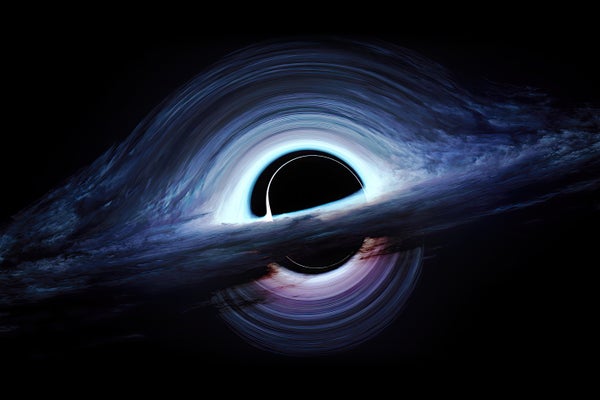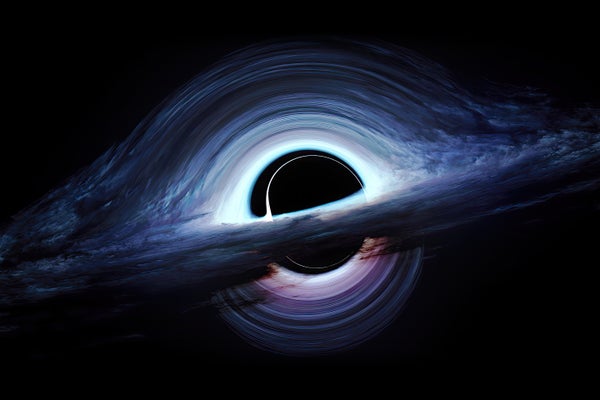September 24, 2024
5 min read
Dark Matter Could Be Hiding Out as Atom-Sized Black Holes
The universe’s hidden mass may be made of black holes, which could wobble the planets of the solar system when they pass by

This story sounds wild—even incredible. Black holes! Dark matter! Jostling planets! Yet the scenario is plausible—and testable soon.
Black holes the size of an atom that contain the mass of an asteroid may fly through the inner solar system about once a decade, scientists say. Theoretically created just after the big bang, these examples of so-called primordial black holes could explain the missing dark matter thought to dominate our universe. And if they sneak by the moon or Mars, scientists should be able to detect them, a new study shows.
Such black holes could have easily arisen right after the universe was born, when space is thought to have expanded hugely in a fraction of a second. During this expansion, tiny quantum fluctuations in the density of space would have grown larger, and some spots may have become so dense that they collapsed into black holes scattered throughout the cosmos. If dark matter is fully explained by such black holes, their most likely mass, according to some theories, would range from 1017 to 1023 grams—or about that of a large asteroid.
If primordial black holes are responsible for dark matter, they probably zip through the solar system about every 10 years, a new study found. If one of these black holes comes near a planet or large moon, it should push the body off course enough to be measurable by current instruments. “As it passes by, the planet starts to wobble,” says Sarah R. Geller, a theoretical physicist at the Massachusetts Institute of Technology and co-author of the study, which was published on September 17 in Physical Review D. “The wobble will grow over a few years but eventually it will damp out and go back to zero.”
On supporting science journalism
If you’re enjoying this article, consider supporting our award-winning journalism by subscribing. By purchasing a subscription you are helping to ensure the future of impactful stories about the discoveries and ideas shaping our world today.
Study team member Tung X. Tran, then an undergraduate student at M.I.T., built a computer model of the solar system to see how the distance between Earth and nearby solar system objects would change after a black hole flyby. He found that such an effect would be most noticeable for Mars, whose distance scientists know within about 10 centimeters. For a black hole in the middle of the mass range, “we found that after three years the signal would grow to between one to three meters,” Tran says. “That’s way above the threshold of precision that we can measure.” The Earth-Mars distance is particularly well tracked because scientists have been sending generations of probes and landers to the Red Planet.
If scientists detect a disturbance, they must determine whether the planet was pushed by a black hole or just a plain old asteroid. By tracking the wobble pattern over time, they can trace the trajectory of the object and predict where it will head in the future. “We actually get really rich information from the pattern of perturbations,” says study co-author Benjamin V. Lehmann of M.I.T. “We’d need to convince ourselves that it’s really a black hole by telling observers where to look.” If the object is an asteroid, telescopes should be able to see it. Plus, most asteroids come from within the solar system and therefore orbit on the same plane as the planets. A primordial black hole, on the other hand, would be coming from far away and would likely have a different trajectory than that of an asteroid.
Another potential way to look for primordial black holes in the solar system would be to analyze data from asteroids, particularly the asteroid Bennu, which has been tracked very precisely by the ongoing space mission OSIRIS-REx (Origins, Spectral Interpretation, Resource Identification, and Security-Regolith Explorer). “After reading [the team’s] paper, I think we can try to dig into OSIRIS-REx data to see if we can see this effect,” says Yu-Dai Tsai, an astrophysicist at Los Alamos National Laboratory. “I think it’s a promising direction to look at.” Tsai and his colleagues studied how the probe’s Bennu measurements could be used to look for other forms of dark matter in a paper published September 20 in the journal Communications Physics.
Primordial black holes are an increasingly appealing solution to the puzzle of dark matter, an invisible form of mass that physicists think makes up most of the matter in our universe. Because they can only “see” this matter through its gravitational effects on regular matter, its identity has remained elusive. Many favored theories of its makeup have failed to pan out. For decades physicists thought dark matter was likely to take the form of so-called weakly interacting massive particles (WIMPs). Yet generations of ever more sensitive experiments meant to find these particles have come up empty, and particle accelerators have also seen no sign of them. “Everything is on the table because WIMPs have been put in such a corner, and they were the dominant paradigm for decades,” says astrophysicist Kevork Abazajian of the University of California, Irvine, who wasn’t involved in the Physical Review D study. “Primordial black holes are really gaining popularity.”
Physicists are also recognizing that dark matter may not interact with regular matter through any force other than gravity. Unlike WIMPs, which could also touch regular matter through the weak force, black holes would be detectable only through their gravitational pull. “Given that we are still searching for the correct way to detect dark matter interacting with ordinary matter, it is particularly important to explore probes based on the gravitational force it produces, which is the only interaction of dark matter whose strength is already known and the only interaction we are sure exists,” says theoretical physicist Tim M. P. Tait of U.C. Irvine, who was also not involved in the M.I.T. team’s new research. “This is a really interesting idea and one that is timely.”
In a coincidence, an independent team published a paper about its search for signs of primordial black holes flying near Earth in the same issue of Physical Review D. The researchers’ simulations found that such signals could be detectable in orbital data from Global Navigation Satellite Systems, as well as gravimeters that measure variations in Earth’s gravitational field. The two papers are complementary, says David I. Kaiser of M.I.T., a co-author of the study on Earth-Mars distance measurements.
Although these black holes could be passing relatively nearby, the chances that one could move through a human body are incredibly low. If that were to happen to you, though, it wouldn’t be fun: as the tiny black hole moved through you, it would tug everything toward it, causing cells to crush together in deadly fashion. Its minuscule volume, however, would at least prevent you from getting sucked in.

